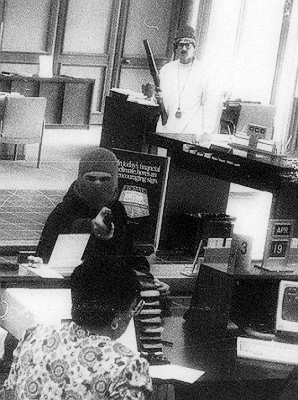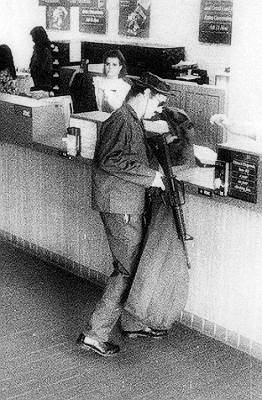THE CAPITALBank Robbery in 1990s Los Angeles
During the decade which spanned 1965 to 1975 the bank robbery 'business' in the United States experienced a resurgence to new found levels, the like of not seen since the heydays of Dillinger, Floyd and Nelson in the 1930s. Armed robberies climbed from a low nationwide total of 850 to what seemed like a staggering 3,500 but by the time another decade had passed Uniform Crime Reports would record a final figure for 1985 at a little under 5,500 with an average of $3,048 being stolen in each event and the statistics for solving these crimes was as at that point as low as 25%.
1990: FBI Uniform Crime Reports show an increase of 1,200 armed robberies from the year previous. (6,691 to 7,837).
1991: Robberies jumped an alarming 20% to 9,388 nationwide. That was one robbery every 16 minutes, every hour of every workday Monday to Saturday, every week, all year long.
The result of such a large increase in this type of crime saw a $61.5 million loss to banking institutions. An average 'take' of $6,559.72 per robbery, although in many cases the bank robber's gain was significantly lower, usually $1,500 - $2,000.
Of those 9,388, shots were fired in 134 cases, three involved explosive devices, 338 acts of violence were recorded in which 157 assaults resulted in 132 injuries, 27 deaths and 135 people being taken hostage. Although 50% of the time the act of aggression was directed at a bank employee statistics show that the bank robber was the one most likely to end the day taking a ride in the coroner's van, primarily due to being confronted by responding police officers.
Bank robbery, despite 'enjoying' a resurgence in popularity, was becoming more violent.
The measures that had been implemented to combat the rising trend were forcing a mindset in those who would commit such a crime.
With bandit barriers, cctv, dye packs, tear gas packs, and tracers all becoming industry standard implementations, Federal Uniform Sentencing Guidelines pushing time served quotas up to 85% and with 25 year sentences for those convicted of such robberies (especially if a firearm was brandished), for a bank robber facing a quarter century behind bars shooting and running was becoming an acceptable escalation to them. For those that were caught their return to the street was not as fast or as simple as it had been in previous decades.
53% of those who committed these robberies would be arrested, with the FBI presenting that a further 20 to 30% would eventually feel the handcuffs click closed around their wrists.
A marked increase from the 25% clearance rate of just six years earlier.
If the bank robbery statistics seem alarming for that span of three years (1989 to 1991) then the story of Los Angeles bank robbery epidemic is one of trend gone truly wild.
In 1978 bank robberies had climbed to over one thousand in the seven county area, pushing Los Angeles into the unenviable blue ribbon title of 'bank robbery capital of the world'.
Worse was yet to come.
1989 saw a street gang, the Rollin' 60 Neighbourhood Crips take opportunism to a new level. Scooping up drug addicts from crack houses they would place a pistol and a robbery note in their hands and all but push them through the doors of the target banks. Recompense, if successful, was either a small amount of money or a few rocks of crack cocaine.
September 5th, 1991 would see a single incident change the face of bank robbery in the Southland.
James A. McGrath and Gilbert Michaels of the small yet successful four man takeover robbery crew called the 'West Hills Bandits' entered a Wells Fargo branch in Tarzana, pulled out a Thompson sub-machine gun (although this is not seen in the photos that follow) and escaped minutes later with $436,000, a record take in the LA jurisdiction.


Bank surveillance photos of the "West Hills Bandits"
The bank publically disclosed exactly how much had been stolen, and offered a $10,000 reward for the apprehension of the bandits but from that point on it was a different ball game.
Takeovers were now 'plat du jour'.
The Rollin' 60's adopted takeovers with a vengeance. They would soon change their name to Rich Rollin' 60's, with cash on the hip they would diversify into many other criminal areas but bank robbery had been their launch pad. Other LA gangs joined the feeding frenzy in an attempt to emulate the Rollin' 60's.
Gang attributed bank robberies in 1991 were counted at 193, in 1992 that number nearly doubled, to 363. Whilst note passing robberies would always have a presence the takeover was now seen as the route to fast easy money. The gangs did not have it all their own way though, May 28th 1993 saw the FBI garner a significant victory with the arrest of Robert Brown and Donzell Thompson, Casper and C-Dog respectively. Two individuals who would be sentenced 30 and 25 year sentences for their part in over 175 robberies despite never having set foot in a bank. These were the men who were scooping up school kids and junkies, giving them a gun and a pillow case and driving them to the target banks. They would pay dearly for their crimes of coercion.

Robert Sheldon Brown

FBI-dubbed "Baby Bandits"
Of the 9,388 2-11s committed nationwide in the nationwide peak year of 1991, 2,355 of those were perpetrated in the seven county sphere of influence of LA's FBI Bank Squad. Statistics will tell you that one in four of the nation's bank robberies was happening in the 469 square miles of Los Angeles, it shows how out of control the epidemic had become.
As bad as 1991 had been, 1992 would be the peak year in Los Angeles. 2,641 bank robberies, 448 takeovers, a robbery every 42 minutes on average.

Emil Matasareanu & Larry Phillips during their 1996 Winnetka takeover bank robbery.
The two subjects of the following pages rode in on the gradual decline of the epidemic using an usual MO with a high propensity for violence. The armed robbery heyday was already over (except for a spike in 2001). By the time they went to 'work' on their final job in 1997, nationwide bank robbery statistics had steadied at around 7,800 and Los Angeles had fallen from a high of 2,641 in the peak year to just 749. They would lift the statistics with an eccentric and grandiose robbery before signing off with a horrific televised gun battle after their plans apparently went awry one sunny morning in North Hollywood, CA.